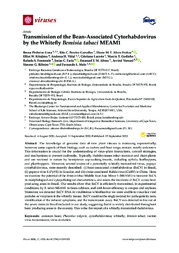Transmission of the bean-associated Cytorhabdovirus by the whitefly Bemisia tabaci MEAM1.
Transmission of the bean-associated Cytorhabdovirus by the whitefly Bemisia tabaci MEAM1.
Autoria: PINHEIRO-LIMA, B.; PEREIRA-CARVALHO, R. C.; ALVES-FREITAS, D. M. T.; KITAJIMA, E. W.; VIDAL, A. H.; LACORTE, C.; GODINHO, M. T.; FONTENELE, R. S.; FARIA, J. C.; ABREU, E. F. M.; VARSANI, A.; RIBEIRO, S. G.; MELO, F. L.
Resumo: The knowledge of genomic data of new plant viruses is increasing exponentially; however, some aspects of their biology, such as vectors and host range, remain mostly unknown.This information is crucial for the understanding of virus?plant interactions, control strategies,and mechanisms to prevent outbreaks. Typically, rhabdoviruses infect monocot and dicot plantsand are vectored in nature by hemipteran sap-sucking insects, including aphids, leafhoppers,and planthoppers. However, several strains of a potentially whitefly-transmitted virus, papayacytorhabdovirus, were recently described: (i) bean-associated cytorhabdovirus (BaCV) in Brazil,(ii) papaya virus E (PpVE) in Ecuador, and (iii) citrus-associated rhabdovirus (CiaRV) in China. Here,we examine the potential of theBemisia tabaciMiddle East-Asia Minor 1 (MEAM1) to transmit BaCV,its morphological and cytopathological characteristics, and assess the incidence of BaCV across beanproducing areas in Brazil. Our results show that BaCV is efficiently transmitted, in experimentalconditions, byB. tabaciMEAM1 to bean cultivars, and with lower efficiency to cowpea and soybean.Moreover, we detected BaCV RNA in viruliferous whiteflies but we were unable to visualize viralparticles or viroplasm in the whitefly tissues. BaCV could not be singly isolated for pathogenicity tests,identification of the induced symptoms, and the transmission assay. BaCV was detected in five out ofthe seven states in Brazil included in our study, suggesting that it is widely distributed throughoutbean producing areas in the country. This is the first report of a whitefly-transmitted rhabdovirus.
Ano de publicação: 2020
Tipo de publicação: Artigo de periódico
Unidade: Embrapa Arroz e Feijão
Palavras-chave: Bemisia Tabaci, Common bean, Feijão, Mosca Branca, Phaseolus Vulgaris, Vector, Vetor, Virus evolution, Vírus, Whitefly
Observações
1 - Por padrão são exibidas publicações dos últimos 20 anos. Para encontrar publicações mais antigas, configure o filtro ano de publicação, colocando o ano a partir do qual você deseja encontrar publicações. O filtro está na coluna da esquerda na busca acima.
2 - Para ler algumas publicações da Embrapa (apenas as que estão em formato ePub), é necessário ter, no celular ou computador, um desses softwares gratuitos. Sistemas Android: Google Play Livros; IOS: iBooks; Windows e Linux: software Calibre.
Acesse outras publicações
Acesse a Base de Dados da Pesquisa Agropecuária (BDPA) para consultar o acervo completo das bibliotecas da Embrapa.

